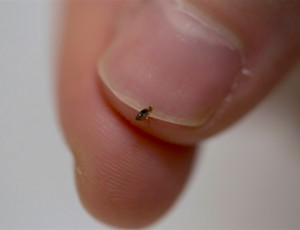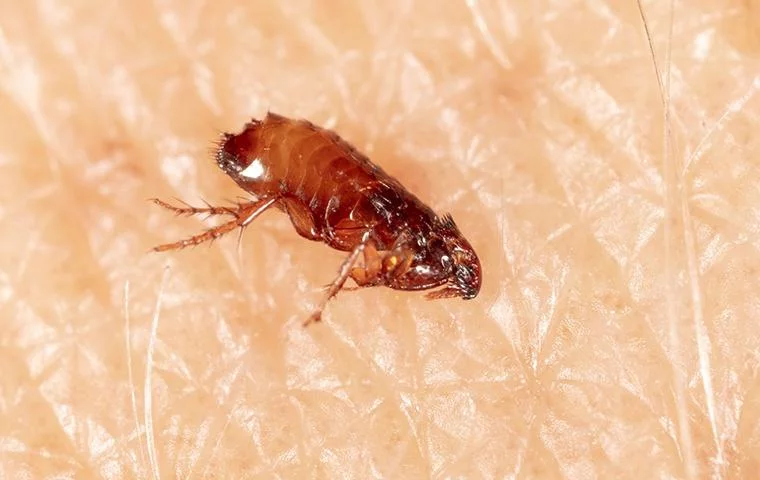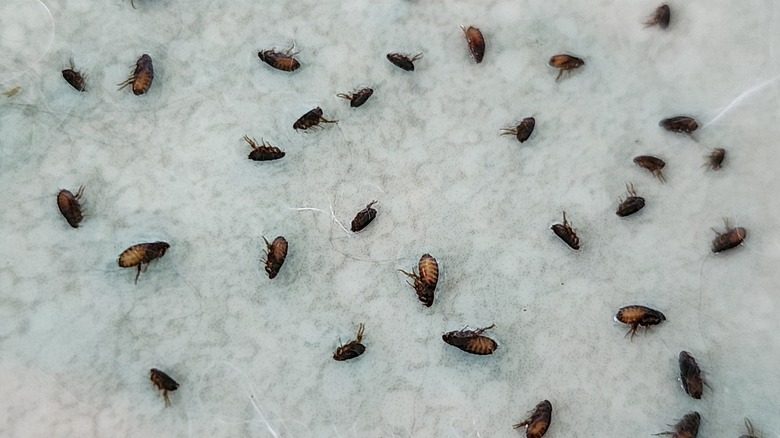Florida’s subtropical climate—marked by warmth, humidity, and brief, mild winters—creates a near-ideal environment for fleas. These tiny, jumping insects depend on blood meals to survive, and both pets and people can become unwitting hosts. Once fleas take hold in a home or business, they can be difficult to remove without professional help. In the coastal regions of Fort Pierce and Vero Beach, where outdoor activities are common and pets often enjoy time outside, fleas can easily hitch rides indoors on furry companions or clothing.
This service page explores why fleas thrive in Florida, how to detect their presence, and why turning to a qualified flea exterminator often yields the best results. Although fleas are small, they multiply quickly and can trigger intense itching, allergic reactions, and even transmit parasites like tapeworms. By understanding their life cycle, preferred habitats, and how best to eliminate them, you can safeguard your living or working space against these persistent pests.
Why Fleas Flourish in Florida

1. Warm, Humid Conditions
Fleas thrive in temperatures between roughly 65°F and 85°F, conditions that Florida experiences for much of the year. Humidity is another critical factor; fleas lay eggs in moisture-rich environments where they are less likely to dry out. Fort Pierce and Vero Beach, with their subtropical coastal climates, consistently provide that combination of warmth and humidity. This allows flea populations to remain active and reproduce, often with minimal seasonal decline.
2. Abundant Wildlife
Beyond domestic pets, Florida’s wildlife—such as raccoons, opossums, and stray cats—can carry fleas onto properties. Even if these animals do not settle in your yard, they may pass through and drop flea eggs or adult fleas near your home or business. Once fleas establish an outdoor population, pets or people walking by can unknowingly pick them up, bringing them inside.
3. Year-Round Pet Activity
Many residents in Fort Pierce and Vero Beach enjoy spending time outdoors with dogs or other companion animals. Fleas often wait in grasses or shaded areas, ready to leap onto a passing host. Regular outings to parks, beaches, or even your own backyard increase the risk of fleas attaching to pets. Without prompt detection and treatment, just a few fleas can multiply into a sizable infestation.
4. Multiple Life Stages
Fleas go through four stages: egg, larva, pupa, and adult. Under the warm, humid conditions prevalent in Florida, fleas complete their life cycle more quickly. This rapid development means that fleas can go from egg to adult in under three weeks, particularly if conditions are ideal. As a result, small flea populations can become major concerns in just a short time, especially if untreated or overlooked.
Telltale Signs of Fleas
1. Excessive Pet Scratching
One of the most obvious indicators of a flea problem is a pet that scratches, bites, or licks its fur more than usual. Fleas commonly gather around the neck, back, and belly of dogs or cats. In severe infestations, pets can develop raw patches or hair loss from constant irritation.
2. Flea Dirt
“Flea dirt” is the polite term for flea feces, which appears as black or dark brown specks on pet bedding, carpets, or fur. When you rub flea dirt with a damp paper towel, it often dissolves into a reddish-brown smear—the remains of digested blood. Even if you do not see adult fleas, the presence of flea dirt strongly suggests an infestation.
3. Bites on People
Flea bites on humans typically occur on the ankles, lower legs, or any exposed skin area that’s easy for fleas to jump onto. The bites often appear as small, red welts that may be grouped in clusters. While the itching can be mild for some, others develop more intense reactions or allergic responses, leading to significant irritation.
4. Pet Restlessness
Beyond scratching, a pet might display unusual restlessness or discomfort, especially at night. In cats, you may notice excessive grooming or hiding behavior. Dogs may whine, pace, or attempt to flee from areas they previously found comfortable, such as their own beds or favorite rugs.
5. Visible Fleas
In moderate to heavy infestations, you may actually see fleas hopping on carpets or furniture. Adult fleas are small—about the size of a sesame seed—and move quickly when disturbed. They appear dark brown or black, making them easier to spot on light-colored surfaces or bedding.
Risks of Ignoring Fleas
1. Rapid Population Growth
Fleas multiply at an astonishing rate under optimal conditions, and Florida’s climate typically meets those requirements. When a female flea begins feeding, she can lay dozens of eggs within a matter of days. Even if you remove adult fleas, eggs and pupae can remain hidden in carpets, upholstery, or pet bedding and re-emerge later.
2. Pet Health Issues
Heavy flea infestations can lead to anemia in pets, particularly in kittens, elderly animals, or those with weakened immune systems. Some pets also develop flea allergy dermatitis, a hypersensitivity to flea saliva that results in severe itching, rashes, and hair loss. Left unaddressed, these conditions may necessitate costly veterinary care.
3. Human Discomfort and Allergies
Although fleas prefer animals, they will bite humans if given the opportunity. Some individuals are more sensitive than others, experiencing persistent itching or welts that can become infected if scratched excessively. In rare instances, fleas may carry diseases or transmit parasites, presenting additional health concerns.
4. Property Infestation
Flea eggs and larvae often hide in the fibers of carpets, rugs, or furniture. When these pupae mature, you can see repeated waves of fleas appearing over time, even if you thought the problem was resolved. Property owners who ignore fleas frequently discover that eradicating them becomes a drawn-out, frustrating process—especially if infestations spread to multiple rooms or outbuildings.
5. Spread to Neighbors
If you live in close proximity to neighbors, fleas can easily travel between yards, especially if pets or wildlife wander freely. Ignoring an infestation in your home may inadvertently lead to neighboring properties facing similar challenges. In multi-unit buildings, fleas could migrate through shared hallways, attics, or vents, causing broader disruptions.

Why a Professional Exterminator Is Crucial
1. Accurate Assessment
Flea infestations are often more extensive than they initially appear. A professional flea exterminator conducts a thorough inspection to identify the extent of the issue, checking hidden areas where fleas might be breeding. This clear assessment guides a targeted treatment plan rather than a “spray and pray” approach.
2. Multi-Stage Treatment
A single round of insecticide may kill adult fleas, but eggs and larvae can remain protected in carpet fibers or pet bedding. Professionals apply methods that address every life stage—adult, larva, and egg—to break the flea life cycle entirely. By focusing on all stages, the exterminator ensures that new fleas do not reappear weeks later.
3. Safe, Targeted Application
DIY solutions can sometimes put people or pets at risk if misapplied or combined with other chemicals. Professionals use proven products and strategies designed for safety and efficacy, often applying them to specific areas like baseboards, furniture crevices, and outdoor pet areas. This precision protects occupants from unnecessary exposure to harsh chemicals.
4. Guidance on Pet and Home Management
Exterminators offer tips on how to prepare your home before treatment—such as washing pet bedding at high heat or vacuuming carpets thoroughly. They also advise on ongoing measures like regular grooming, vacuuming, or yard maintenance. Combining professional interventions with good hygiene practices sets the stage for lasting relief.
5. Follow-Up and Prevention
Because flea eggs can hatch after an initial treatment, many exterminators schedule follow-up visits to ensure the infestation is fully gone. During these visits, they check high-risk zones, apply additional products if needed, and evaluate whether any new fleas have hatched. This ongoing support helps guarantee that the problem is resolved, instead of merely postponed.
Typical Methods for Flea Treatments
1. Inspection and Preparation
Before applying any treatments, an exterminator inspects the entire property—indoors and out. They look for signs of fleas in carpets, rugs, pet bedding, and shaded outdoor spots. They may recommend vacuuming, laundering pet bedding, and tidying up clutter to facilitate a more thorough treatment.
2. Insect Growth Regulators (IGRs)
One effective strategy against fleas involves using an insect growth regulator—chemicals that disrupt the flea’s life cycle by preventing larvae from maturing into adults. When combined with adulticides, IGRs ensure that both current and future generations of fleas are halted.
3. Targeted Insecticides
Technicians may apply insecticides along baseboards, under furniture, and near pet rest areas, where fleas are most likely to feed and lay eggs. These products are carefully chosen to kill adult fleas on contact while offering residual protection against newly emerging fleas. Occupants might be asked to leave the premises briefly to allow the treatments to dry.
4. Outdoor Treatments
Flea control often extends to yards, patios, or gardens if pets spend significant time there. Exterminators focus on shaded, humid areas—like under bushes, decks, or dog runs—where fleas typically hide. Treating both indoor and outdoor spaces is crucial if your pets move in and out regularly.
5. Vacuuming and Cleanup
Vacuuming is an essential step. By removing flea eggs, larvae, and debris from rugs and furniture, you reduce the number of fleas waiting to develop. After treatment, exterminators frequently emphasize continued vacuuming of carpets and upholstery to catch any newly hatched fleas or eggs.

Service Areas
Fort Pierce
Located on Florida’s Treasure Coast, Fort Pierce enjoys warm temperatures throughout the year—ideal conditions for fleas. Whether you own a single-family home on a quiet street or manage a vacation rental property near the water, fleas can take hold swiftly in this subtropical environment. With the help of a seasoned flea exterminator, you can maintain a welcoming, pest-free atmosphere for family, tenants, or guests.
Vero Beach
Just north of Fort Pierce, Vero Beach boasts cultural attractions, pristine beaches, and upscale residences. Despite its charm, Vero Beach is not immune to flea infestations. Pets moving between indoor comfort and outdoor recreation, along with native wildlife passing through yards, create regular opportunities for fleas to settle in. Professional treatments in Vero Beach target both the indoor environment and surrounding outdoor areas to ensure a comprehensive defense.
Why Our Flea Treatments Excel
1. Florida-Specific Expertise
Years of experience dealing with fleas in Florida’s subtropical climate inform our approach. We know when fleas are most active, the local wildlife vectors involved, and how to adapt our methods to the region’s humidity and temperatures for maximum effectiveness. By customizing our strategies for Fort Pierce and Vero Beach properties, we deliver consistent results.
2. Thorough Inspections and Tailored Solutions
We begin each job with a meticulous property inspection, identifying hotspots like pet bedding, carpets, and lawn areas. Drawing from these observations, we design a treatment plan that addresses the entire flea life cycle—resulting in a more complete and lasting outcome.
3. Emphasis on Safety and Minimal Disruption
Using targeted products and informed application techniques, we minimize risk to people, pets, and the environment. Our exterminator team provides clear instructions about any necessary precautions, including ventilation or reentry times. We aim to cause as little interruption to your routine as possible.
4. Ongoing Education and Support
We believe that preventing future flea outbreaks is just as important as solving the current one. After treatments, we offer guidance on home care, pet grooming, yard maintenance, and vacuuming schedules. If you notice any signs of returning fleas, we’re ready to reevaluate and provide additional support as needed.
5. Prompt Response and Reliable Results
Flea populations can erupt quickly—time is of the essence once they appear. By responding swiftly to service inquiries, we help you prevent small flea issues from spiraling into large-scale infestations. Our focus on accurate identification, multi-phase treatment, and continuous follow-up ensures you can rest easier knowing that fleas won’t have a chance to overtake your space.
Next Steps
If you suspect fleas are in your home—whether you’ve spotted them on pets, noticed bites on your ankles, or found unexplained black specks in your carpets—don’t wait. Contact us to learn more or schedule your service. Early intervention curbs the spread of fleas, ultimately saving you time, stress, and financial resources.
Our approach targets every stage of the flea’s life cycle, combining proven tools and strategies to eliminate these pests inside and out. Whether you live in Fort Pierce, Vero Beach, or the surrounding areas, professional exterminator assistance can help restore your property to a comfortable, flea-free state. By tackling fleas head-on and following the necessary steps to prevent future issues, you protect your home, pets, and loved ones from the discomfort and potential health concerns these insects bring.
Maintaining a Flea-Free Environment
- Regular Pet Checks
Use a flea comb on your pets, checking for adult fleas or flea dirt, especially around the neck, belly, and tail. Consult a veterinarian about monthly or quarterly flea preventatives tailored to your pet’s needs. - Frequent Vacuuming
Vacuum carpets, rugs, and upholstery several times a week, paying special attention to areas where pets rest or sleep. Dispose of the vacuum contents promptly in a sealed bag outside your home to prevent re-infestation. - Wash Pet Bedding
Launder pet bedding, blankets, and pillows in hot water and high-heat drying cycles, which effectively kill fleas, eggs, and larvae. Establishing a routine for washing these items ensures fleas never gain a strong foothold. - Yard Maintenance
Fleas thrive in shady, damp spots. Mow your lawn regularly to keep grass short, trim bushes or shrubs, and clear away leaf litter or debris. If you suspect fleas in outdoor pet areas, consider safe yard treatments recommended by your exterminator. - Secure Entry Points
Inspect your home’s foundation, windows, and doors for gaps that animals could use to enter. Even small openings allow stray cats, rodents, or wildlife carrying fleas to take shelter, inadvertently introducing fleas onto your property. - Stay Alert for New Activity
Fleas can return if eggs or pupae remain hidden after an initial treatment. Monitor common problem areas, and consult a professional if you see fresh flea signs. Staying vigilant means you can catch and address minor issues before they spread.
By integrating these measures into your daily or weekly routines, you help keep fleas from becoming a persistent nuisance in your household or workspace. Coupled with professional exterminator support in Fort Pierce and Vero Beach, a proactive approach gives you peace of mind, letting you and your pets enjoy Florida’s sunny lifestyle without the itch and worry fleas bring.
